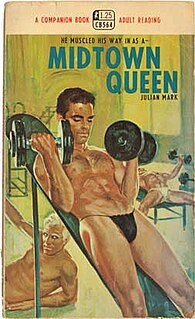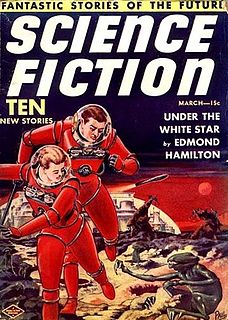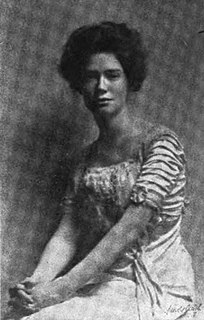
Pulp magazines were inexpensive fiction magazines that were published from 1896 to the late 1950s. The term pulp derives from the cheap wood pulp paper on which the magazines were printed. In contrast, magazines printed on higher-quality paper were called "glossies" or "slicks". The typical pulp magazine had 128 pages; it was 7 inches (18 cm) wide by 10 inches (25 cm) high, and 0.5 inches (1.3 cm) thick, with ragged, untrimmed edges.

Weird Tales is an American fantasy and horror fiction pulp magazine founded by J. C. Henneberger and J. M. Lansinger in late 1922. The first issue, dated March 1923, appeared on newsstands February 18. The first editor, Edwin Baird, printed early work by H. P. Lovecraft, Seabury Quinn, and Clark Ashton Smith, all of whom would go on to be popular writers, but within a year the magazine was in financial trouble. Henneberger sold his interest in the publisher, Rural Publishing Corporation, to Lansinger and refinanced Weird Tales, with Farnsworth Wright as the new editor. The first issue under Wright's control was dated November 1924. The magazine was more successful under Wright, and despite occasional financial setbacks it prospered over the next fifteen years. Under Wright's control the magazine lived up to its subtitle, "The Unique Magazine", and published a wide range of unusual fiction.

William Tenn was the pseudonym of Philip Klass, a British-born American science fiction author, notable for many stories with satirical elements.

Murphy C. Anderson, Jr. was an American comics artist, known as one of the premier inkers of his era, who worked for companies such as DC Comics for over fifty years, starting in the Golden Age of Comic Books in the 1940s. He worked on such characters as Hawkman, Batgirl, Zatanna, the Spectre, and Superman, as well as on the Buck Rogers daily syndicated newspaper comic strip. Anderson also contributed for many years to PS, the preventive maintenance comics magazine of the U.S. Army.

Fiction House was an American publisher of pulp magazines and comic books that existed from the 1920s to the 1950s. It was founded by John B. "Jack" Kelly and John W. Glenister. By the late 1930s, the publisher was Thurman T. Scott. Its comics division was best known for its pinup-style good girl art, as epitomized by the company's most popular character, Sheena, Queen of the Jungle.

Swank is an adult or pornographic magazine published in the United States. The first incarnation was launched by Victor Fox of Fox Comics in 1941 as a men's lifestyle and pin-up magazine in the style of Esquire. Around 1954–1955, it was relaunched by Martin Goodman, the founder of Marvel Comics, and ran spicy adventure or suspense fiction by the likes of Ian Fleming, Graham Greene, Norman Mailer and Arthur C. Clarke. Humorist Bruce Jay Friedman was an editor in the late 1950s.

Space Science Fiction was a science fiction magazine published by Space Publications, Inc. of New York and The Archer Press Ltd. of London that ran for eight issues from May 1952 to September 1953. Space was edited by Lester del Rey and featured a book review column by George O. Smith. Del Rey's conflicts with the publishers ensured that the magazine would have a short run, in spite of the superior quality of the stories. Illustrator Alex Ebel contributed to this magazine over the course of his career.

Gay pulp fiction, or gay pulps, refers to printed works, primarily fiction, that include references to male homosexuality, specifically male gay sex, and that are cheaply produced, typically in paperback books made of wood pulp paper; lesbian pulp fiction is similar work about women. Michael Bronski, the editor of an anthology of gay pulp writing, notes in his introduction, "Gay pulp is not an exact term, and it is used somewhat loosely to refer to a variety of books that had very different origins and markets". People often use the term to refer to the "classic" gay pulps that were produced before about 1970, but it may also be used to refer to the gay erotica or pornography in paperback book or digest magazine form produced since that date.

Venture Science Fiction was an American digest-size science fiction magazine, first published from 1957 to 1958, and revived for a brief run in 1969 and 1970. Ten issues were published of the 1950s version, with another six in the second run. It was founded in both instances as a companion to The Magazine of Fantasy & Science Fiction. Robert P. Mills edited the 1950s version, and Edward L. Ferman was editor during the second run. A British edition appeared for 28 issues between 1963 and 1965; it reprinted material from The Magazine of Fantasy & Science Fiction as well as from the US edition of Venture. There was also an Australian edition, which was identical to the British version but dated two months later.

Worlds Unknown was a science-fiction comic book published by American company Marvel Comics in the 1970s, which adapted classic short stories of that genre, including works by Frederik Pohl, Harry Bates, and Theodore Sturgeon.

Nina Rapi is a Greek award-winning playwright and short story writer. She has lived in London for many years but has recently returned to Greece and now lives in Athens.
David Anthony Kraft also credited simply as David Kraft, is an American comic book writer, publisher, and critic. He is primarily known for his long-running journal of interviews and criticism, Comics Interview.

Avon Fantasy Reader was a digest size magazine which reprinted science fiction and fantasy literature by now well-known authors. It was edited by Donald A. Wollheim and published by Avon. The magazine had one spin off, Avon Science Fiction Reader, with which it merged on its cancellation to become Avon Science Fiction and Fantasy Reader.

Future Science Fiction and Science Fiction Stories were two American science fiction magazines that were published under various names between 1939 and 1943 and again from 1950 to 1960. Both publications were edited by Charles Hornig for the first few issues; Robert W. Lowndes took over in late 1941 and remained editor until the end. The initial launch of the magazines came as part of a boom in science fiction pulp magazine publishing at the end of the 1930s. In 1941 the two magazines were combined into one, titled Future Fiction combined with Science Fiction, but in 1943 wartime paper shortages ended the magazine's run, as Louis Silberkleit, the publisher, decided to focus his resources on his mystery and western magazine titles. In 1950, with the market improving again, Silberkleit relaunched Future Fiction, still in the pulp format. In the mid-1950s he also relaunched Science Fiction, this time under the title Science Fiction Stories. Silberkleit kept both magazines on very slim budgets throughout the 1950s. In 1960 both titles ceased publication when their distributor suddenly dropped all of Silberkleit's titles.
Short Stories was an American fiction magazine that existed between 1890 and 1959.
Argosy magazine was the title of three magazines published in the United Kingdom, one in the late 19th century, another in the middle of the 20th century, and the other, very briefly, in the early 21st century.

Alden Spurr McWilliams generally credited as Al McWilliams and A. McWilliams, was an American comics artist who co-created the first African-American lead character of a comic strip. He won the National Cartoonists Society's 1978 award for Comic Book: Story.

Marion Polk Angellotti was an American author.

Flash Gordon Strange Adventure Magazine was a pulp magazine which was launched in December 1936. It was published by Harold Hersey, and was an attempt to cash in on the growing comics boom, and the popularity of the Flash Gordon comic strip in particular. The magazine contained a novel about Flash Gordon and three unrelated stories; there were also eight full-page color illustrations. The quality of both the artwork and the fiction was low, and the magazine only saw a single issue. It is now extremely rare.

Amazing Stories Quarterly was a U.S. science fiction pulp magazine that was published between 1928 and 1934. It was launched by Hugo Gernsback as a companion to his Amazing Stories, the first science fiction magazine, which had begun publishing in April 1926. Amazing Stories had been successful enough for Gernsback to try a single issue of an Amazing Stories Annual in 1927, which had sold well, and he decided to follow it up with a quarterly magazine. The first issue of Amazing Stories Quarterly was dated Winter 1928 and carried a reprint of the 1899 version of H.G. Wells' When the Sleeper Wakes. Gernsback's policy of running a novel in each issue was popular with his readership, though the choice of Wells' novel was less so. Over the next five issues, only one more reprint appeared: Gernsback's own novel Ralph 124C 41+, in the Winter 1929 issue. Gernsback went bankrupt in early 1929, and lost control of both Amazing Stories and Amazing Stories Quarterly; his assistant, T. O'Conor Sloane, took over as editor. The magazine began to run into financial difficulties in 1932, and the schedule became irregular; the last issue was dated Fall 1934.

















